| . 1 . 2 . >> |
| Author |
Message |
MtnDon
Member
|
# Posted: 22 Jul 2014 15:16
Reply
Lightning! Lightning struck the cabin and three tall pines nearby. It seems likely this happened Wednesday evening, July 16. There was a severe thunderstorm warning for the area that evening. We were not at the cabin; we had left on the 11th. The rain gauge indicated 1.75" of rain and the water tracks on the slopes would seem to back that up.
We arrived Thursday morning the 17th. While Don was outside turning on the power to the inverter, Karen was inside puzzling over the pieces of plastic debris on the floor inside the cabin. When Don closed the breaker to power up the inverter he was greeted by a pop from inside the inverter and then a curl of smoke; the breaker then popped open. Don went inside. He noticed the plastic on the floor was from the wall plate cover for the 24 volt ceiling fan. Looking at the wall he saw the fan control dangling from the wall box. The wall was slightly blackened at one corner of the box and electronic parts were blackened as well.
Damages we discovered included:
The Outback VFX3524M power inverter / charger is non functional and has something burnt inside; smells like the magic smoke escaped.
The Outback FM60 charge controller is non functional and we can see some small electronic parts have been blown open. The magic smoke has definitely escaped. When unmounted from the wall various plastic and semi conductor shrapnel fell out.
The data cables interconnecting the charge controller, hub4 and inverter / charger have blackened connectots. The socket at the charge controller end blew off the circuit board.
The circuit breaker between the PV panels and the charge controller exploded. The top of the casing blew off and a hole was blown out one side. The breaker to the batteries tripped but is apparently undamaged.
The PVC conduit that carries the wires from the PV panels up to the cabin charge controller exploded open in ten different spots over a hundred and forty foot run. At one point the insulation on one of the wires is melted. All breaks occurred at the glue joints. ??? Only two joints in the 140 feet were undamaged. Further up the hill the conduit was undamaged.
The lightning arrestor on the PV mount pole has the end blown out of it. The ground wire from the arrestor to ground lug has melted insulation.
One fuse in the 24 to 12 volt converter blew violently, incinerating the fuse housing and leaving mostly ash behind. The second fuse housing was intact but very blackened. Unfortunately replacing the fuses did not restore functionality.
The LED Christmas lights strung along the porch and north wall to the shed were severely damaged. One 5 foot stretch had all the LED's and their sockets blown over a 7 to 10 foot radius. At the back end of the cabin the light wire was blown apart, completely severed. There are flame or electric arc marks on a one foot length of fascia board along the roof gable end.
A join in the aluminum gutter on the south side of the roof was blown apart. There are light grey ghostly trace marks like contour marks on a topo map on the white paint.
There are black scorch marks around the bolt head where a ground wire connects to the metal roof.
At the gazebo where the 120 VAC electrical conduit emerges from the buried line there used to be a 90 degree PVC elbow fitting where the wires enter the gazebo wall. That elbow was blown apart and pieces found up to 40 feet away. That circuit is entirely external to the cabin. The circuit breaker buzzed loudly when trying to reset it. Testing indicates the GFCI outlet that is first in the chain of electrical connections, blew. At least with the GFCI temporarily jumpered the breaker resets.
Three trees approximately 20 to 30 feet from the SW cabin corner show ample evidence of lightning strike. Bark chunks, strips blown off and many small branches littered the ground. We can see strips blown off way up the trunks and closer to the ground. Strangely in the more or less center area of the three trees that were struck there is an equal sized tree that was untouched.
When I rewired things to by pass the toasted inverter / charger and temporarily connect generator power to the cabin the fan on the propane wall heater ran and would not shut off. That fan is only supposed to run when the heater is hot. There are small scorch marks on the receptacle and heater fan power plug ground connector. One thought is that the lightning power entered the heater via the exterior direct vent ductwork. The ground wire from the fan cord connects to the fan motor which is bolted to the metal combustion chamber. The thermostat switch is mounted to the exterior of the combustion chamber. That switch was found blown apart. ....
The LCD TV will not power up at all. The DVD-R clock lights when plugged in but the unit will not power up. Both were plugged in but the wall outlet was turned off. The TV antenna cable was connected though. The TV antenna lead in wire was connected to a ground rod via one of those coax wire terminal blocks.
The Yamaha inverter generator was connected to the cabin power system via the inverter / charger. The engine starts, but the engine races at maximum speed and there is no power at the outlets. The outlet that is supposed to provide 12 VDC for battery charging produces approx 36+ VDC. It would appear the magic smoke escaped from the generators electronic speed and power control system.
The portable air conditioner ran for 5 seconds and then the LCD display went dark and the motor ceased running. It has not wanted to resume operation.
The good news is that the PV panels are still producing power. The batteries were fully charged with a reading of about 25.3 volts on our arrival and in seemingly good shape. Neither the cabin, out-buildings or the forest caught fire. I wired up a temporary jumper to provide 12 volt DC to the DC powered lights and water pumps. The microwave works as do the other small appliances...using generator power.
There is also a small dent in the metal roofing. Not a downward dent as might happen with a falling object striking the roof, but an upward bulge as is struck from below.
It must have been an exciting time with lots going on.
Photos later
|
|
bobrok
Member
|
# Posted: 22 Jul 2014 16:34
Reply
Mtn. Don & Karen:
I'm sure I speak for everyone on this forum when I offer my sympathy on your awful misfortune. I hope you have insurance coverage for all of this and I hope (make that...I KNOW) that you will be back, and better than ever.
Thank God you weren't there when it happened. You could have been killed.
bob
|
|
rayyy
Member
|
# Posted: 22 Jul 2014 17:24
Reply
I so sorry to hear this Folks.This is my greatest fear at my cabin.This site we chose to build on had a beautiful pine tree that was deader than a door nail ,I assumed it was hit by lightning.So now every time a thunder storm rumbles through,I cring!
|
|
optimistic
Member
|
# Posted: 22 Jul 2014 17:24
Reply
How terrible! But really happy to hear you two weren't hurt!
Everything can be replaced but your loved ones.
I am sure you will have your beautiful place up an running shortly!
|
|
CabinBuilder
Admin
|
# Posted: 22 Jul 2014 17:27
Reply
 
|
|
cabingal3
Member
|
# Posted: 22 Jul 2014 17:30
Reply
MtnDon.
so happy u and wife are alright.
goodness.
so sorry.pretty wild goings on there.
hope u get things repaired soon.
|
|
razmichael
Member
|
# Posted: 22 Jul 2014 17:50
Reply
So sorry to hear the damage done - but, as has been already said, so glad nobody was hurt and the damage is limited to electrical stuff that can be replaced.
|
|
Ontario lakeside
Member
|
# Posted: 22 Jul 2014 17:57
Reply
MtnDon
Sorry to hear about your trouble, we fear lightning at our place. the soil is to shallow to make a good ground. Im glad no one was hurt and that the building survived ok.
|
|
|
bldginsp
Member
|
# Posted: 22 Jul 2014 18:48
Reply
Glad you didn't suffer anything worse, like a spark-initiated fire. The equipment can be replaced, home is harder to replace.
One of the reasons we provide a ground connection to earth in electrical systems is to deal with lightning. Theoretically, the lightning is directed safely to earth. But in reality electricity takes as many paths as it wants to to get from here to there, and if the wattage through a given path is too much for what it's passing through, well, you know better than I.
There was a house here hit by lightning some years ago that had a standard ground rod and conductor to the service. Despite this, receptacles exploded, sheetrock nail heads popped out under the sheetrock mud, and tile exploded off the walls when the current passed through the chicken wire beneath and instantly evaporated the moisture in the mortar.
Glad that you are OK. When the mood strikes, would you describe what connection to earth your system has, and any thoughts you have about its performance.
|
|
Woodeye
Member
|
# Posted: 22 Jul 2014 19:33
Reply
I am so sorry to hear the bad news. On the other hand your point by point description of the damage done is very interesting.
|
|
naturelover66
Member
|
# Posted: 22 Jul 2014 20:07
Reply
Glad you're ok and your cabin didn't burn down!!
You will have everything up and running in no time . Be safe.
|
|
groingo
Member
|
# Posted: 22 Jul 2014 20:57 - Edited by: groingo
Reply
Will insurance help or are they going the "act of god" route and do nothing?
|
|
MtnDon
Member
|
# Posted: 22 Jul 2014 21:13
Reply
Quoting: bldginsp When the mood strikes, would you describe what connection to earth your system has, and any thoughts you have about its performance.
The metal roof itself has two ground paths to earth; #8 solid copper, each to a ground rod, 8 foot.
That is separate from the electrical system grounding; also using #8 bare copper to two ground rods. The ground rods here are series connected to the master ground buss.
Damage may have been avoided if air terminals (lightning rods) had been used along the gable peak with proper braided copper down wires connecting to ground rods or plates. Those are going to be installed soon... Air terminals with the braided type wire to two grounds on opposite corners on the cabin plus a set on the barn and the shed TV mast. Probably one on the gazebo metal chimney.
The arrestors used were the common Delta. They were old but seemed okay. However, I knew about the Midnite Solar brand being better (and have promoted them) but never got around to changing. MN have an LED that indicates being operational as well as being more robust and repairable. I will be ordering several of their model 300 and perhaps one model 115 when I order their charge controller. One one every line in and out of the power center.
So two things that are different but similar in that they both connect to the earth.
|
|
bldginsp
Member
|
# Posted: 22 Jul 2014 23:34
Reply
I've often wondered how effective ground rods are in western soils that see no rain for months in summer. Plates present a far broader area for contact.
You said that you have two separate ground systems, one for the roof and one for the elec system. Not sure, but I thought the prevailing wisdom goes that all rods should be tied together, partly just to give more opportunity to any potential on any part of the system to find earth, but also so that there cannot be a difference of potential between two different systems. Not sure how this might have contributed, or not, to your strike damage.
On the mountain top observation towers they have in the Western US for spotting fires, they will run several heavy solid copper grounds from the building down the side of the mountain for hundreds of feet, buried only a few inches if at all. The more area in contact with earth the better.
I neglected, much to my chagrine, to bury ground wire in the several trenches I dug around my cabin foundation for water and septic. I do have a Ufer though, which I hope is enough because I'm on a hip of the mountain, with good tree cover but still somewhat exposed.
|
|
MtnDon
Member
|
# Posted: 22 Jul 2014 23:56
Reply
I was told that the two systems are okay separate if truly separated. Issues can arise when a power system, AC or DC, has ground rods that have wires going to different parts of the power system. That's the reason a power system should have a buss where grounds from different circuits and different equipment all converge. From there the main ground connects to the first ground and then the second and so on where there are multiple power system grounds. And lightning surge suppressor would connect to the power system ground.
Then the lightning protection system is handled separately as a complete different system. At least that is what the lightning contractor / vendor said today.
Re the mountain soils... that can vary a lot I suppose but I have found that once I'm down two or three feet the soil we have is moist. I also placed my ground rods where the soil is wet from eves runoff and from the waste water system drainage. Although I did find out today the lightning grounds should be 2 feet out from the cabin wall line and should be buried / driven a full foot below the surface.
|
|
MtnDon
Member
|
# Posted: 22 Jul 2014 23:57
Reply
Christmas tree LED lights; LED's blown apart, slight scorching on fascia, hard to see with the string still in place
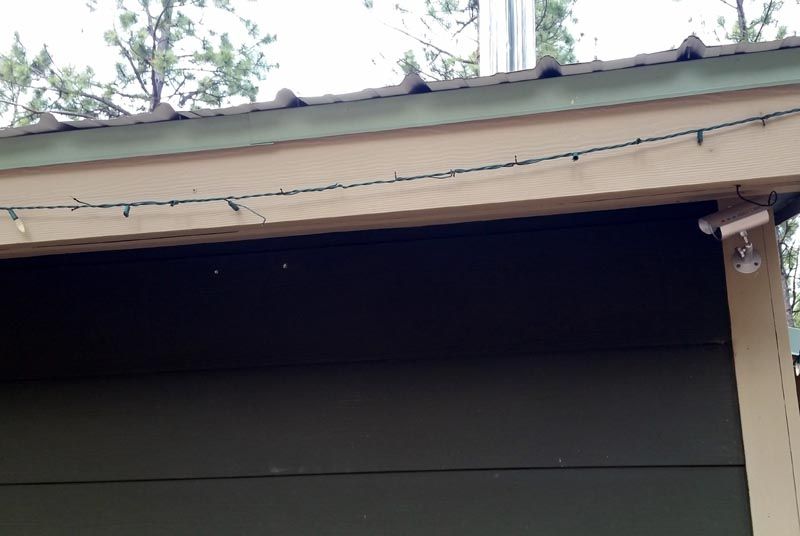
Must have been some big sparks flying here. LED light string blown apart. The LED string made a 90 turn at the eye where it then ran to the shed along with the TV coax and a carrier rope. I'm thinking of spraying a clear coat on that to preserve the memory.
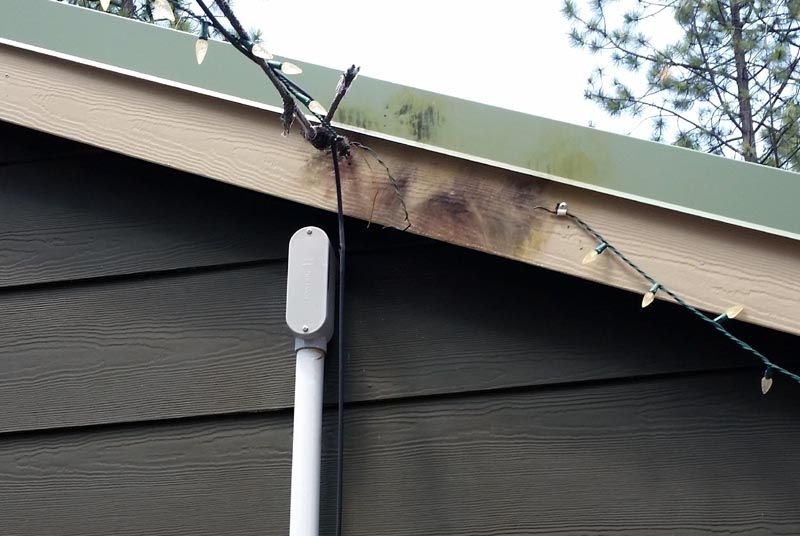
Bottom of one of the struck trees. It's difficult to get good photos of the strips torn off in 8 foot lengths farther up thr trunk. Those extended 50 feet or so up the tree.
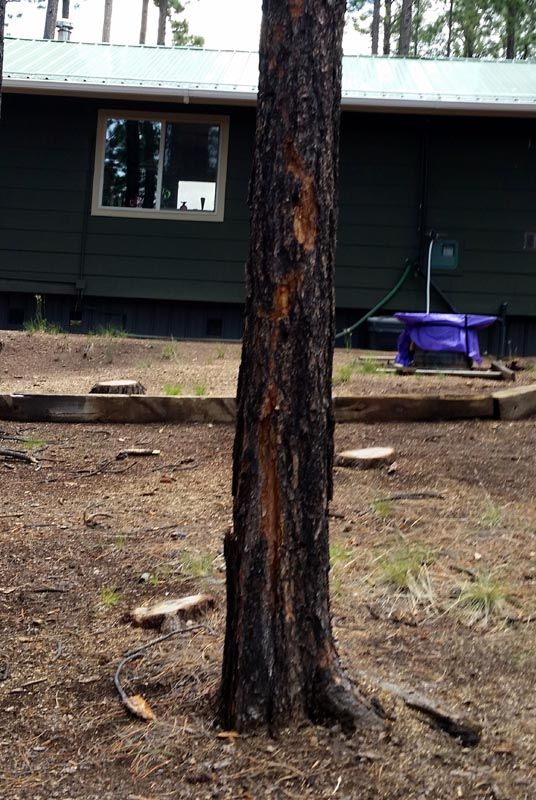
One of the other struck trees. We'll have to wait and see if they are affected.
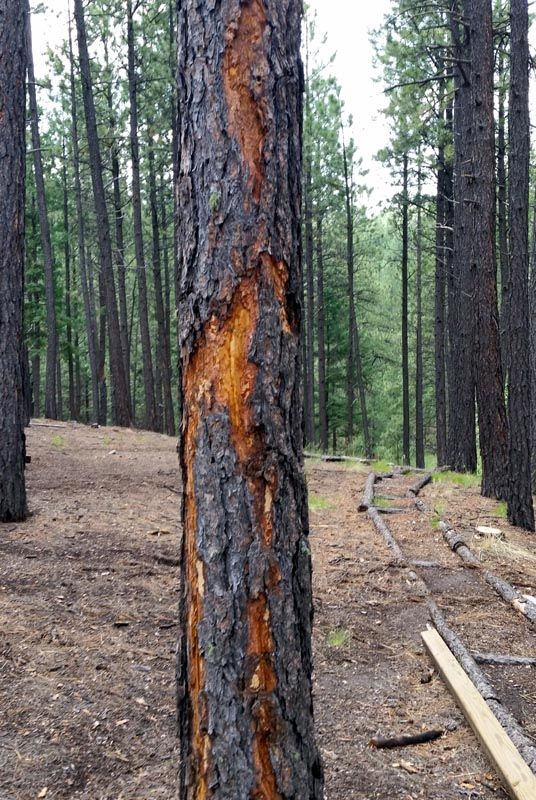
Power line entrance to the gazebo.
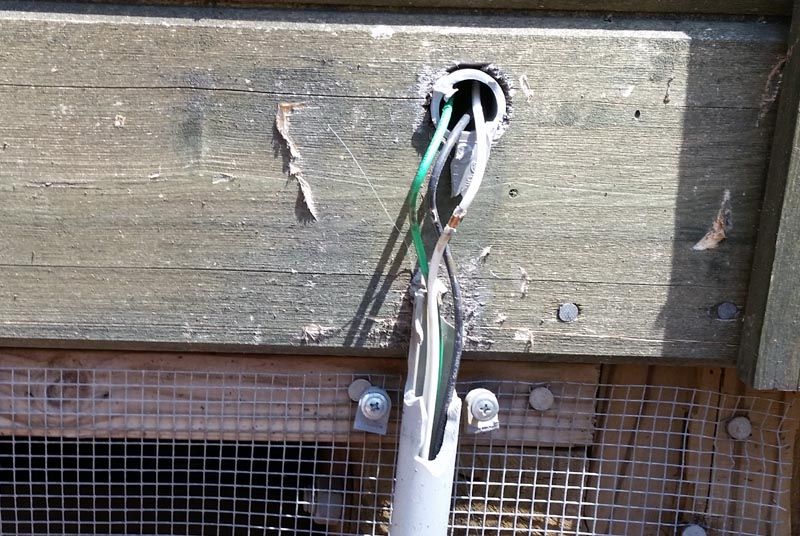
That was a fitting similar to this...
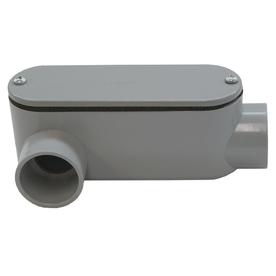
The fan speed control. The pot (with the black knob) blew apart and slifgtly scorched the wall as it fragmented the wall plate.

The DC breaker that exploded. This was the breaker at the charge controller in the incoming line.

The FM60 charge controller connections panel. The green data cable connector socket was blown apart. Other assorted debris, some of which is in the bottom of the CC. Scorch marks.
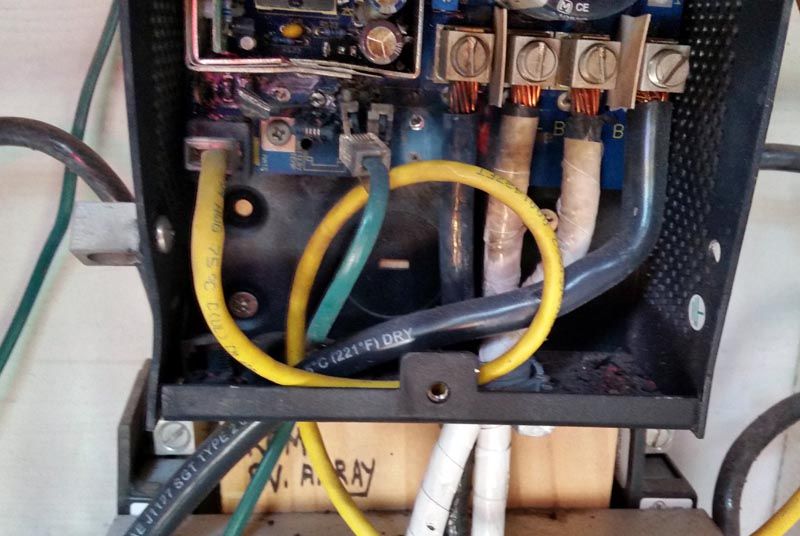
|
|
MtnDon
Member
|
# Posted: 22 Jul 2014 23:58
Reply
The smallest conduit fracture

One of the longer fractures
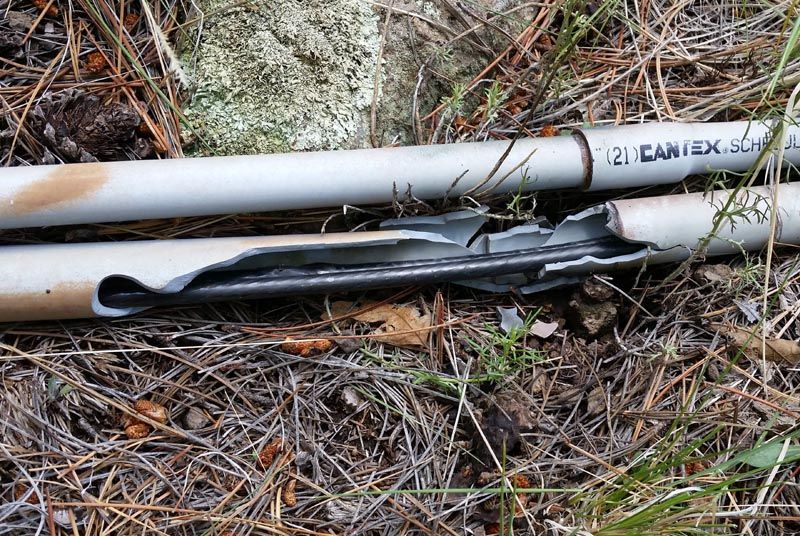
And the one section where the insulation was melted
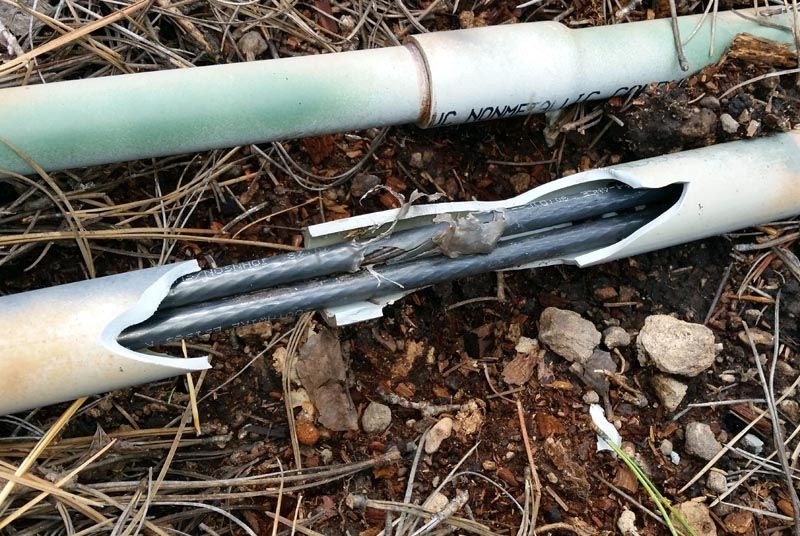
Assorted souvenirs. The white pieces are the fan speed control wall plate. The black device is the DC circuit breaker. 150 VDC 15 ampere. In the center are gazebo box parts and some conduit.

The propane heater fan thermostat

The plug and receptacle it was plugged into

The roof panel; 24 gauge steel. The photo was taken after I gave the bump a couple of whacks and tried to tighten the screw which was backed off or pulled out about 3/4 inch. I need to get some larger gauge screws to be able to tighten that down correctly.
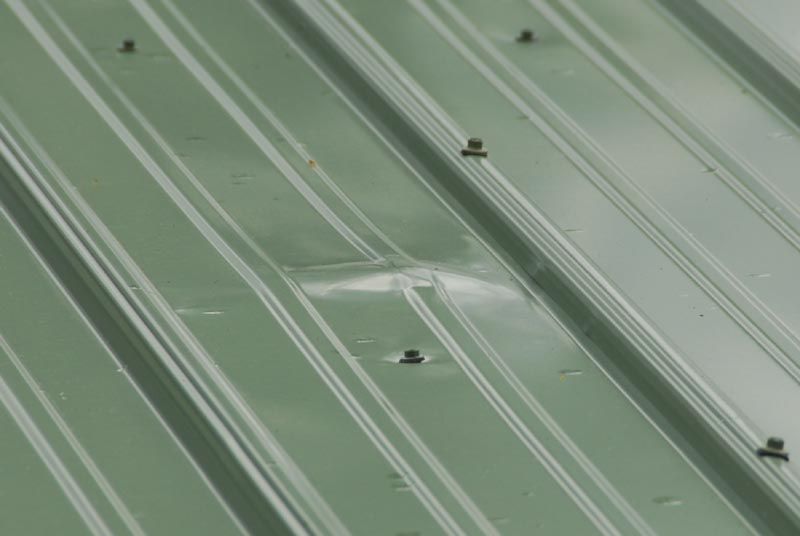
|
|
CabinBuilder
Admin
|
# Posted: 23 Jul 2014 08:26
Reply
Wow... 
Thanks for the details, MtnDon - quite sobering.
Not sure if anything could be done to divert that much power.
|
|
toyota_mdt_tech
Member
|
# Posted: 23 Jul 2014 09:02
Reply
Wow Don, lucky the place didnt catch fire and burn down! Loads of damage too. Crazy. Looks like lots of labor and expense for you to get it back in operation. Sorry to hear that.
|
|
MtnDon
Member
|
# Posted: 23 Jul 2014 09:59
Reply
Quoting: toyota_mdt_tech lucky the place didnt catch fire and burn down!
I suspect it was pouring rain at the time as the rain gauge was showing 1.75" and there were indications of there being some large amounts of run off on the slopes.
|
|
groingo
Member
|
# Posted: 23 Jul 2014 11:24 - Edited by: groingo
Reply
That rise in your roof, was there anything electrical behind that other than plywood sheeting, that is just plain strange.
Having survived 3 near lightning strike misses one only ten feet away, another happened on a chrystal clear day, struck a large maple tree followed the roots, went under the driveway and came up through the wall via the plumbing and blew the toilet off the floor and part way out the back wall.
But that roof dent of yours is most interesting.
|
|
MtnDon
Member
|
# Posted: 23 Jul 2014 11:50
Reply
No electrical, no plumbing, nothing but #30 building felt, OSB and some nails.
|
|
MtnDon
Member
|
# Posted: 23 Jul 2014 17:42
Reply
Guy on another forum sent me this...
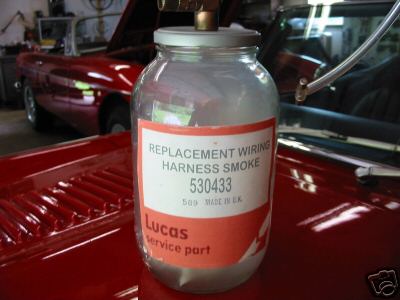
Could be handy. 
|
|
MtnDon
Member
|
# Posted: 23 Jul 2014 17:44
Reply
Quoting: groingo Will insurance help
Not covered
|
|
PatrickH
Member
|
# Posted: 23 Jul 2014 17:54
Reply
The magic smoke is tough to come by, sorry for your losses but that is some impressive damage.Gives you a chance to build it bigger and better now. Glad you are safe.
|
|
neb
Member
|
# Posted: 23 Jul 2014 20:55
Reply
Very sorry to hear your lose. It looks like you have some work to do.
|
|
sparky1
Member
|
# Posted: 24 Jul 2014 17:03
Reply
so sorry for your losses..at least the cabin still there & you all were NOT there.
sparky1
|
|
suburbancowboy
Member
|
# Posted: 24 Jul 2014 18:13
Reply
So are you going to rebuild your system the same or do you plan on making changes? I'm interested because I based my system on your schematics.
Also is it possible that the lightning tried to enter or exit through your roof, causing the metal to heat and expand, giving the exiting bulge?
|
|
toyota_mdt_tech
Member
|
# Posted: 24 Jul 2014 20:06
Reply
Quoting: MtnDon Guy on another forum sent me this...
Don, as an automotive tech, Lucas was an acronym for "Let Us Create A Short"
|
|
bldginsp
Member
|
# Posted: 24 Jul 2014 21:06
Reply
Lucas, Prince of Darkness
|
|
| . 1 . 2 . >> |

